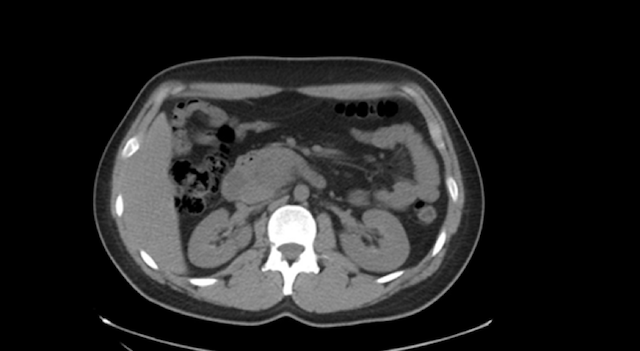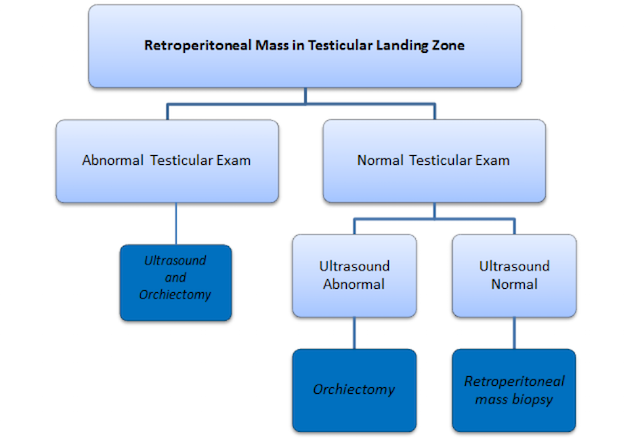Article
Challenging cases in urology: CT indicates germ cell tumor, but no palpable testicular mass present
A 25-year-old male presents with 4 weeks of intermittent right flank pain occasionally radiating to the testicle. CT shows a 7-cm partially necrotic retroperitoneal mass at the level of the right renal vein and a 2-cm lesion overlaying the right psoas muscle.
“Challenging Cases in Urology” is a new Urology Times section in which residents from the nation’s leading urology programs present their toughest cases and how they ultimately managed them. Cases inform readers of the problem-solving process and provide a lesson from the authors’ experience.
Dr. Davuluri is a urology resident at Montefiore Health System, Bronx, NY.
History
A 25-year-old male patient presented to the emergency department with 4 weeks of intermittent right flank pain occasionally radiating to the testicle. He reported minimal relief with acetaminophen or ibuprofen. Patient reported he was otherwise healthy. He was treated for one episode of right scrotal swelling 10 months prior with ibuprofen and antibiotics, with regression of the swelling. He reported that no imaging was done at that time. He denied any dysuria, urgency, frequency, hematuria, nausea/vomiting, fever, chills, or shortness of breath.
Examination
Physical examination revealed a well-developed 25-year-old male. He had no right costovertebral angle tenderness. Testicular exam revealed palpable testicles bilaterally that were normal in shape and size. The right testicle was soft compared to that of a normal testicle. Both testicles were non-tender to palpation.
Also see: Hematuria in a man with prune belly syndrome
A computed tomography scan obtained in the emergency department demonstrated a 7-cm partially necrotic retroperitoneal mass at the level of the right renal vein and an additional 2-cm lesion overlaying the right psoas muscle (figure 1). Tumor markers including AFP, HCG, and LDH were ordered and slightly elevated to 211, 27, and 317, respectively. A scrotal ultrasound was obtained at this time, which showed a normal-sized right testicle with a heterogeneous appearance and poorly delineated mass within the right testicle. The left testicle was normal.

Figure 1. CT scan demonstrating large retroperitoneal mass (Image courtesy of Meena Davuluri, MD)
Next: What's your diagnosis?
Discussion and diagnosis
This patient presents without a palpable testicular mass, but abnormal CT findings and elevated tumor markers consistent with non-seminomatous germ cell tumor (NSGCT). There is a phenomenon known as “burned-out tumors,” in which a testicular primary tumor will spontaneously regress. Despite regression, the tumor maintains metastatic potential. The exact etiology of this regression is unknown, but various theories have been hypothesized. A possible immunologic response has been described in which the cell-mediated system can detect common tumor antigens after repetitive exposure (BJU Int 2004; 94:74-8). A second hypothesis is ischemia induced to the tumor cells from rapid proliferation and inability to maintain adequate blood supply (Int J Androl 1987; 10:163-8).
Read: Persistent ureteral stone in a 76-year-old male
Burned-out tumors can be either seminoma or non-seminoma and are differentiated by tumor markers (BJU Int 2004; 94:74-8; Int J Androl 1987; 10:163-8; Wein AJ, Kavoussi LR, Partin AW, Peters CP, editors. Campbell-Walsh Urology. 11th ed. Philadelphia: Elsevier; 2016) In our patient, his markers were consistent with non-seminomatous germ cell neoplasm.
The challenge in this case is determining if this is a primary retroperitoneal NSGCT versus a primary testicular NSGCT that has metastasized to the retroperitoneum. On testicular exam, this patient does not have a palpable mass, which could be due to a burned-out testicular tumor.
Also see: A case of hydronephrosis, sepsis, and pain
Approximately 5% of primary germ cell tumors are extragonadal (retroperitoneal or mediastinal) in origin (Wein AJ, Kavoussi LR, Partin AW, Peters CP, editors. Campbell-Walsh Urology. 11th ed. Philadelphia: Elsevier; 2016). While primary retroperitoneal NSGCTs have similar prognostic potential as primary testicular NSGCTs, primary mediastinal NSGCTs are known to be more aggressive with a poorer 5-year survival rate compared to primary testicular tumors (J Clin Oncol 2002; 20:1864-73). Despite similar survival prognostics between primary retroperitoneal and primary testicular NSGCT, it is important in this case to distinguish if the patient's retroperitoneal mass is a primary tumor or secondary metastasis. This is because of difference in surgical management. If the patient's retroperitoneal mass is metastatic from a primary testicular NSGCT, a radical orchiectomy is still required as part of the initial treatment. However, extragonadal primary tumors do not require an orchiectomy (figure 2).

Figure 2. Algorithm for determination of primary vs. secondary retroperitoneal mass (Figure courtesy of Meena Davuluri, MD)
Next: "It can be difficult to determine if an extragonadal mass is a primary or secondary mass without a clear palpable mass in the testicle or positive imaging"
It can be difficult to determine if an extragonadal mass is a primary or secondary mass without a clear palpable mass in the testicle or positive imaging. In cases of metastatic disease without a palpable testicular mass, a burned-out tumor can be found in approximately one-third of the cases. An additional one-third of these patients show intratubular germ cell neoplasia (precursor to testicular cancer) (Ann Oncol 2002; 13:121-4).
Therefore, in cases concerning for a burned-out tumor versus a primary retroperitoneal tumor, scrotal imaging should be obtained (Wein AJ, Kavoussi LR, Partin AW, Peters CP, editors. Campbell-Walsh Urology. 11th ed. Philadelphia: Elsevier; 2016). Imaging can often be helpful in these cases because while no mass is palpable on physical exam, ultrasound may show a scar or calcifications that may represent a burned-out tumor phenomenon.
It has been shown that burned-out tumors may demonstrate microcalcifications in atrophic testicles, poorly circumscribed hyperechoic and hypoechoic areas, or macrocalcifications in the testicle (J Ultrasound Med 2003; 22:515-21). If there is any suspicion on scrotal ultrasound for a possible burned-out tumor, radical orchiectomy is warranted (Wein AJ, Kavoussi LR, Partin AW, Peters CP, editors. Campbell-Walsh Urology. 11th ed. Philadelphia: Elsevier; 2016).
These risks, benefits, and possibilities were discussed extensively with our patient. His initial scrotal presentation 10 months prior to our encounter had a high likelihood of being a missed testicular cancer. He now re-presented with a retroperitoneal mass and elevated tumor markers. This history, coupled with his ultrasound findings along with the very low probability of a primary retroperitoneal tumor, made a burned-out tumor much more likely. After full discussion, he chose to proceed with a right radical orchiectomy.
Read: General urologists less likely to utilize third-line OAB treatments
The pathology revealed area of scarred testis consistent with burned-out tumor and intratubular germ cell neoplasia. The patient recovered well from the surgery. He immediately followed up with medical oncology and began chemotherapy with bleomycin + etoposide + cisplatin for treatment of retroperitoneal mass.
Conclusion
Burned-out tumors are very rare clinical scenarios in which the primary testicular tumor spontaneously regresses. However, these tumors maintain malignant potential. In testicular cancer, it is important to distinguish burned-out tumors from primary retroperitoneal tumors because primary testicular cancer tumors will still require a radical orchiectomy. Therefore, when evaluating young healthy men with a retroperitoneal mass and no palpable testicular mass, it is prudent to consider various neoplasms in the differential, including the possibility of a burned-out tumor.
Scrotal ultrasound should still be obtained in these patients, as characteristics of a burned-out tumor may be seen and may assist in decision-making. Ultimately, a thorough discussion with the patient including the possibility of burned out tumor is necessary and critical in treating this disease.
More from Urology Times:
Guideline-based medicine: A take-away from the AUA oral board exam
Why your practice should consider team-based care
[Quiz]: Abnormality seen in post-PCNL imaging
To get weekly news from the leading news source for urologists, subscribe to the Urology Times eNews.















